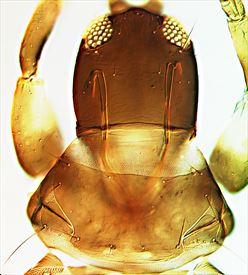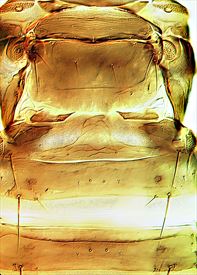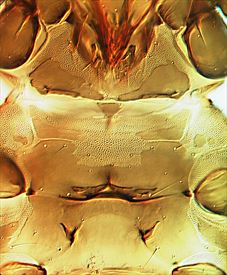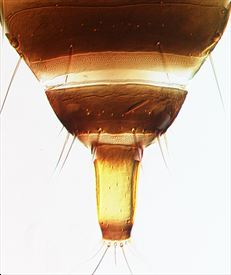
Antenna

Head & pronotum

Meso & metanotum, pelta & tergites II-III

Thoracic sternites

Tergites VIII-IX & tube
Distinguishing features
Female fully winged or micropterous. Body brown; antennal segment II yellow with brown markings, III pale brown with base of pedicel yellow; inner apices of femora yellow; major setae dark; tube golden yellow, with base and apex brown; fore wing shaded, slightly paler distally. Head nearly as wide as long; dorsal surface with faint lines of sculpture; compound eyes not large; ocelli present; 1 pair of postocular setae long and fine; maxillary stylets wide apart, V-shaped, retracted about halfway into head. Antennae 7-segmented but with complete suture beteween VII and VIII; segments V–VII with distinct pedicels; segment III with 2 sense cones, IV with 4. Pronotum with faint lines of sculpture on posterior margin, and with setae long and finely acute; basantra present; mesopresternum and anterior margin of eusternum eroded medially. Sternopleural sutures present. Mesonotum reticulate in anterior half; midlateral setae short. Metanotum with longitudinal lines of sculpture in posterior half. Fore tarsal tooth absent. Fore wings parallel-sided, with 3 sub-basal setae, subequal in length, and with 4–6 duplicated cilia. Abdomen: pelta reticulate, with broad lateral lobes; tergites II–VII each with 1 pair of sigmoid wing-retaining setae; tergite IX setae bluntly pointed, about half as long as tube; tube shorter than head, constricted at apex. Microptera similar but ocelli almost absent; metanotum broad; fore wing lobe oval and bearing 3 variable setae; tergites II–VII without sigmoid wing-retaining setae but II with 1 pair of curved wing-retaining setae.
Male micropterous. Similar to female, but usually smaller; fore femora swollen; fore tarsal tooth large; tergite II with 2 pairs of long setae laterally; sternites IV–VI with lateral reticulations anterior to discal setae.
Related species
The genus Ozothrips appears to be closely related to Heptathrips and Cleistothrips, and includes five species, all known only from New Zealand. Although similar in structure to O. eurytis, the tube of tubulatus is a clear yellow colour medially.
Biological data
Spore-feeding, but nothing is known of the biology because most to the 40 known specimens were collected by sweeping or taken in traps during various months of the year.
Distribution data
Known only from New Zealand (AK, BP, WI-WN).
Family name
PHLAEOTHRIPIDAE, IDOLOTHRIPINAE
Species name
Ozothrips tubulatus Mound & Walker
Original name and synonyms
Ozothrips tubulatus Mound & Walker, 1986: 37
References
Mound LA & Palmer JM (1983) The generic and tribal classification of spore-feeding Thysanoptera (Phlaeothripidae: Idolothripinae). Bulletin of the British Museum (Natural History). Entomology 46: 1–174.
Mound LA & Walker AK (1986) Tubulifera (Insecta: Thysanoptera). Fauna of New Zealand 10: 1–140.